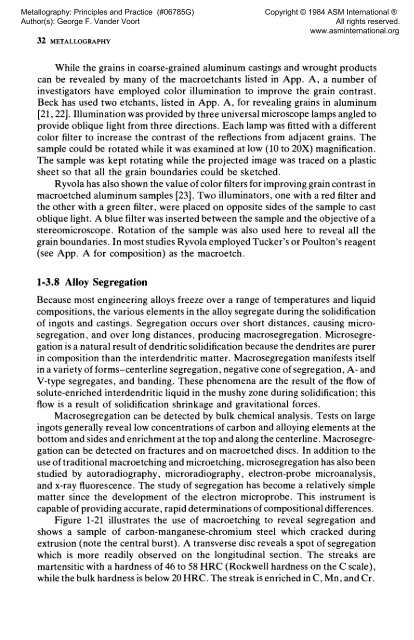Metallography: Principles and Practices - ASM International
Metallography: Principles and Practices - ASM International
Metallography: Principles and Practices - ASM International
You also want an ePaper? Increase the reach of your titles
YUMPU automatically turns print PDFs into web optimized ePapers that Google loves.
<strong>Metallography</strong>: <strong>Principles</strong> <strong>and</strong> Practice (#06785G)<br />
Author(s): George F. V<strong>and</strong>er Voort<br />
32 METALLOGRAPHY<br />
While the grains in coarse-grained aluminum castings <strong>and</strong> wrought products<br />
can be revealed by many of the macroetchants listed in App. A, a number of<br />
investigators have employed color illumination to improve the grain contrast.<br />
Beck has used two etchants, listed in App. A, for revealing grains in aluminum<br />
[21,22]. Illumination was provided by three universal microscope lamps angled to<br />
provide oblique light from three directions. Each lamp was fitted with a different<br />
color filter to increase the contrast of the reflections from adjacent grains. The<br />
sample could be rotated while it was examined at low (10 to 20X) magnification.<br />
The sample was kept rotating while the projected image was traced on a plastic<br />
sheet so that all the grain boundaries could be sketched.<br />
Ryvola has also shown the value of color filters for improving grain contrast in<br />
macroetched aluminum samples [23]. Two illuminators, one with a red filter <strong>and</strong><br />
the other with a green filter, were placed on opposite sides of the sample to cast<br />
oblique light. A blue filter was inserted between the sample <strong>and</strong> the objective of a<br />
stereomicroscope. Rotation of the sample was also used here to reveal all the<br />
grain boundaries. In most studies Ryvola employed Tucker's or Poulton's reagent<br />
(see App. A for composition) as the macroetch.<br />
1-3.8 Alloy Segregation<br />
Copyright © 1984 <strong>ASM</strong> <strong>International</strong> ®<br />
All rights reserved.<br />
www.asminternational.org<br />
Because most engineering alloys freeze over a range of temperatures <strong>and</strong> liquid<br />
compositions, the various elements in the alloy segregate during the solidification<br />
of ingots <strong>and</strong> castings. Segregation occurs over short distances, causing microsegregation,<br />
<strong>and</strong> over long distances, producing macrosegregation. Microsegregation<br />
is a natural result of dendritic solidification because the dendrites are purer<br />
in composition than the interdendritic matter. Macrosegregation manifests itself<br />
in a variety of forms-centerline segregation, negative cone of segregation, A- <strong>and</strong><br />
V-type segregates, <strong>and</strong> b<strong>and</strong>ing. These phenomena are the result of the flow of<br />
solute-enriched interdendritic liquid in the mushy zone during solidification; this<br />
flow is a result of solidification shrinkage <strong>and</strong> gravitational forces.<br />
Macrosegregation can be detected by bulk chemical analysis. Tests on large<br />
ingots generally reveal low concentrations of carbon <strong>and</strong> alloying elements at the<br />
bottom <strong>and</strong> sides <strong>and</strong> enrichment at the top <strong>and</strong> along the centerline. Macrosegregation<br />
can be detected on fractures <strong>and</strong> on macroetched discs. In addition to the<br />
use of traditional macroetching <strong>and</strong> microetching, microsegregation has also been<br />
studied by autoradiography, microradiography, electron-probe microanalysis,<br />
<strong>and</strong> x-ray fluorescence. The study of segregation has become a relatively simple<br />
matter since the development of the electron microprobe. This instrument is<br />
capable of providing accurate, rapid determinations of compositional differences.<br />
Figure 1-21 illustrates the use of macroetching to reveal segregation <strong>and</strong><br />
shows a sample of carbon-manganese-chromium steel which cracked during<br />
extrusion (note the central burst). A transverse disc reveals a spot of segregation<br />
which is more readily observed on the longitudinal section. The streaks are<br />
martensitic with a hardness of 46 to 58 HRC (Rockwell hardness on the C scale),<br />
while the bulk hardness is below 20 HRC. The streak is enriched in C, Mn, <strong>and</strong> Cr.
















